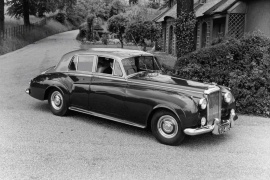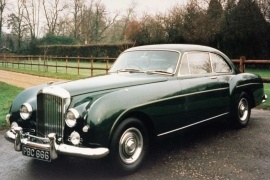BENTLEY S1 Models/Series Timeline, Specifications & Photos
First production year: 1955
Engines: Gasoline
Body style: Coupé (two-door)
Rolls-Royce's sister company was the Bentley, and the 1955 S1 was a re-badged Silver Cloud.
While in the Rolls-Royces the owners were chauffeured, Bentley built its cars to be driven by their owners. They were more spirited and more involving than their more luxurious siblings. But even by the 1950s standards, a two-ton car couldn't be considered a sporty one. At the same time, in the U.S., Ford had the Thunderbird, which was faster but not as luxurious as a Bentley.
At the front, the body-on-frame car featured a different front fascia than the Rolls-Royce. Instead of the Spirit of Ecstacy, it sported a B-winged badge on top of the pinned-out radiator but had the same headlights and the same chromed bumper. Wide, hand-crafted fenders flanked the long and tall engine compartment. Its steep and slightly curved windshield opened the way for the greenhouse. Its sloped-down roof was continued by a short, almost vertical rear windscreen and a trunk.
Its leather-clad interior featured a pair of seats at the front and a bench in the back. On the backside of the seatbacks of the front seats, Bentley installed retractable wood tables. There were other wood trims on the dashboard and door cards, but not from the same wood as in the Silver Cloud.
Under the hood, the carmaker installed an inline-six engine rated at 175 hp, but Bentley didn't publish an official figure in those times. In 1956, the carmaker included power steering and air-conditioning on the options list.
After being purchased by Rolls-Royce, Bentley started to offer badge-engineered vehicles from its owner, and so was the situation with the S1 Continental, which was a Rolls-Royce Silver Cloud in disguise.
After launching the S1 Continental in a four-door version, the Crewe-based brand introduced a two-door version named Drophead Coupe. It was clear that the Bentley brand was focused on the driver's pleasure in handling the car and not on being driven in it.
It was a time when carmakers started to lose the formerly used fenders and create the so-called ponton-shaped vehicles, where the side panels formed a continuous area. Yet, at the front, the designers didn't know exactly how to deal with the headlights and placed them between the engine compartment and the inner sides of the fenders in separate, lower-mounted clusters. The grille was still massive, and instead of Rolls-Royce's statue, there was the "Flying-B" badge. On the car's sides, the long doors made the ingress and egress easier for four occupants, even though it was a car designed mainly for the front seats. The curved, sloped trunk lid followed an arched line toward the chromed bumper at the back.
Inside, at the front, there was a pair of bucket seats separated by a center armrest. The dash panel covered in wood featured a center-mounted radio. In front of the driver, Bentley installed the speedometer and tachometer, placed in front of the three-spoke steering wheel. At the same time, in front of the passenger was the glove compartment and an analog clock. Finally, in the back, the carmaker placed a leather-wrapped bench with a folding armrest in the middle.
Under the hood, the carmaker used the same 4.9-liter inline-six powerplant carried over from Rolls-Royce. In addition, the four-speed GM Hydra-Matic gearbox was available starting in 1956.

